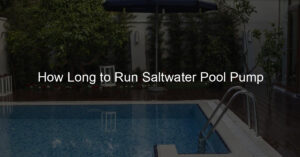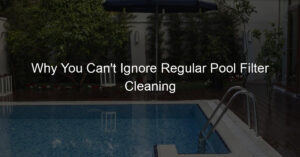Introduction to Natural Swimming Pools
Swimming pools have been a popular feature in homes and public spaces for many years. However, in recent times, a new trend has emerged – natural swimming pools. These eco-friendly alternatives to traditional swimming pools are gaining popularity for their unique features and environmental benefits. In this section, we will explore what natural swimming pools are, their history, and their growing popularity.
-
- Definition of Natural Swimming Pools
Natural swimming pools, also known as organic or eco-friendly pools, are a type of swimming pool that does not rely on chemicals for purification. Instead, they use a natural filtration system, often involving plants and microorganisms, to keep the water clean and safe for swimming. These pools are designed to blend in with the natural environment, often resembling a pond or lake.
-
- History and Evolution of Organic Swimming Pools
The concept of natural swimming pools originated in Europe in the 1980s. The first natural swimming pool was built in Austria by a company called Biotop. The idea was to create a pool that was in harmony with nature, using plants and natural processes to purify the water. Over the years, the design and technology of natural swimming pools have evolved, with many different styles and systems now available.
-
- Popularity and Growth of Eco-friendly Pools
Over the past decade, the popularity of natural swimming pools has grown significantly. According to a report by Grand View Research, the global natural swimming pool market size was valued at USD 133.1 million in 2019 and is expected to grow at a compound annual growth rate (CAGR) of 4.8% from 2020 to 2027. This growth is driven by increasing consumer awareness about the environmental impact of traditional swimming pools and a desire for more sustainable options.
Natural Swimming Pool Designs
When it comes to natural swimming pools, there are a variety of designs to choose from. Each design has its own unique features and benefits. Let’s explore some of the most popular types of natural swimming pool designs.
Types of Natural Swimming Pool Designs
-
- Freeform Natural Pools
Freeform natural pools are designed to mimic the look and feel of a natural pond or lake. They often feature irregular shapes, natural stone, and lush landscaping. These pools are perfect for those who want a pool that blends seamlessly with the surrounding landscape.
-
- Formal Natural Pools
Formal natural pools, on the other hand, combine the best of both worlds. They have the clean lines and geometric shapes of a traditional pool, but use natural filtration systems and plants to keep the water clean. This type of pool is ideal for those who prefer a more structured look but still want the benefits of a natural pool.
-
- Natural Infinity Pools
Natural infinity pools are designed to give the illusion that the pool extends to the horizon. They are often built on a slope and feature a disappearing edge. With their stunning views and eco-friendly design, natural infinity pools are a luxurious choice for any home.
-
- Natural Lagoon Pools
Natural lagoon pools are designed to resemble a tropical lagoon. They often feature sandy beaches, waterfalls, and tropical plants. This type of pool is perfect for those who want to create a backyard oasis.
Choosing the right design for your natural swimming pool depends on your personal preferences, the available space, and the overall look you want to achieve. No matter which design you choose, a natural swimming pool is a beautiful and eco-friendly addition to any home.
Choosing the Right Design for Your Space
Creating a natural swimming pool is an exciting project. But, it’s important to choose a design that fits your space perfectly. Here are three key factors to consider:
- Assessing Your Landscape
First, take a good look at your landscape. What is the shape of your yard? Is it flat or hilly? The answers to these questions can help you decide on the best pool design. For example, if your yard is hilly, a freeform natural pool might be a good choice. This type of pool can be designed to fit the natural contours of your land.
- Considering Your Lifestyle
Next, think about your lifestyle. Do you like to host parties? If so, a larger pool with plenty of space for guests might be ideal. Or, if you prefer quiet relaxation, a smaller, more secluded pool could be perfect. Remember, your pool should enhance your lifestyle, not complicate it.
- Designing for Functionality and Aesthetics
Finally, consider both functionality and aesthetics. Your pool should be practical, but it should also be beautiful. Think about the materials you want to use. Natural stone, for example, can create a rustic, organic look. On the other hand, sleek tiles can give your pool a more modern feel.
In conclusion, choosing the right design for your natural swimming pool involves assessing your landscape, considering your lifestyle, and balancing functionality and aesthetics. By keeping these factors in mind, you can create a pool that is not only beautiful but also perfectly suited to your needs.
DIY Natural Swimming Pools
Building your own natural swimming pool can be a rewarding project. It not only provides a refreshing oasis in your backyard but also contributes to a healthier environment. Here are the steps to create your own natural swimming pool.
Steps to Building Your Own Natural Pool
-
- Planning and Designing
Before you start digging, it’s important to plan and design your pool. Consider the size, shape, and location. You’ll also need to decide on the type of plants and wildlife you want to attract. Remember, the design should blend with the natural surroundings to create a harmonious environment.
-
- Excavating and Shaping
Once you have a design, it’s time to start excavating. This involves digging the pool and shaping it according to your design. Be sure to consider the depth and slope of the pool, as these factors will affect the water circulation and the pool’s ability to self-clean.
-
- Installing the Liner and Filtration System
After excavating, you’ll need to install a liner to prevent the water from seeping into the ground. Then, install a filtration system. This system uses plants and microorganisms to clean the water, eliminating the need for chemicals.
-
- Adding Plants and Finishing Touches
Finally, add plants around and in the pool. These plants will not only beautify the pool but also help in filtering the water. You can also add finishing touches like stones, pebbles, or a wooden deck to enhance the natural look.
In conclusion, building a natural swimming pool requires careful planning and execution. But the result is a beautiful, eco-friendly pool that provides a refreshing retreat and promotes biodiversity in your backyard.
Organic Pool Maintenance
Organic pools, also known as natural swimming pools, require a unique approach to maintenance. Unlike traditional pools, they rely on natural processes to keep the water clean and safe. This section will cover three key aspects of organic pool maintenance: maintaining water quality, managing plants and wildlife, and seasonal care and cleaning.
-
- Maintaining Water Quality
Water quality is crucial in any pool, but it’s especially important in organic pools. These pools use plants and beneficial bacteria to filter the water naturally. To maintain water quality, you need to monitor the balance of nutrients in the water. Too many nutrients can lead to algae growth, while too few can harm the plants and wildlife that keep the pool clean.
Regular testing is essential. You can use a simple water testing kit to check the levels of nutrients like nitrogen and phosphorus. If the levels are too high, you may need to add more plants or beneficial bacteria to your pool. If they’re too low, you might need to add a natural fertilizer.
-
- Managing Plants and Wildlife
Plants and wildlife play a vital role in organic pool maintenance. They help to filter the water and keep it clean. But managing them can be a challenge. You need to choose the right plants for your pool, and you need to make sure they’re thriving.
Some plants are better at filtering water than others. For example, water lilies and cattails are excellent at absorbing nutrients and preventing algae growth. You also need to consider the wildlife in your pool. Frogs, insects, and other creatures can help to keep the pool clean, but you need to make sure they’re not causing any problems.
-
- Seasonal Care and Cleaning
Every season brings new challenges for organic pool maintenance. In the spring, you might need to clean out any debris that’s accumulated over the winter. In the summer, you’ll need to monitor the water temperature and nutrient levels closely to prevent algae blooms. In the fall, you’ll need to prepare your pool for the colder months ahead.
Regular cleaning is also essential. This doesn’t mean using harsh chemicals, but rather removing debris, trimming plants, and checking the pool’s systems to make sure everything is working correctly.
In conclusion, organic pool maintenance requires a different approach than traditional pool care. But with a little knowledge and effort, you can keep your pool clean, safe, and beautiful all year round.
Benefits of Natural Swimming Pools
When it comes to swimming pools, the natural option offers a plethora of benefits that extend beyond just a refreshing dip. These benefits range from being eco-friendly to promoting health and wellness, and even enhancing biodiversity and landscape value. Let’s delve into these benefits in more detail.
-
- Eco-friendly Pool Alternatives
Natural swimming pools are a fantastic alternative to traditional chlorine pools. They are designed to function like a mini-ecosystem, using plants and natural microorganisms to keep the water clean. This eliminates the need for harmful chemicals, reducing your carbon footprint and making it a more eco-friendly option. Plus, the water consumption is significantly lower than traditional pools as the water in natural pools does not need to be regularly replaced.
-
- Health and Wellness Benefits
Swimming in natural water is not just refreshing, it’s also beneficial for your health. The absence of chlorine and other chemicals means you won’t experience dry skin, red eyes, or other common irritations associated with traditional pools. Moreover, the presence of plants and natural elements in the pool can create a calming environment, promoting mental wellness. It’s like having your own personal oasis right in your backyard.
-
- Enhancing Biodiversity and Landscape Value
Natural swimming pools can significantly enhance the biodiversity of your backyard. The plants used in the pool attract a variety of insects and birds, creating a vibrant ecosystem. Moreover, these pools can be designed to blend seamlessly with your landscape, adding aesthetic value to your property. In fact, a well-designed natural swimming pool can increase the overall value of your property.
In conclusion, natural swimming pools offer a multitude of benefits that make them a worthwhile investment. They are eco-friendly, promote health and wellness, and enhance the biodiversity and landscape value of your property. So, if you’re considering installing a pool, a natural swimming pool might just be the perfect choice for you.
Natural Swimming Pool Construction
Building a natural swimming pool is a unique process that involves the use of specific materials and techniques. This section will delve into the details of these components, providing you with a comprehensive understanding of how natural swimming pools are constructed.
Materials and Techniques
When constructing a natural swimming pool, the choice of materials and the techniques employed play a significant role in the pool’s functionality and sustainability. Let’s take a closer look at these aspects.
-
- Using Natural and Recycled Materials
Natural swimming pools are built with a focus on sustainability, which is why natural and recycled materials are often used in their construction. For instance, clay and gravel are commonly used instead of concrete and fiberglass. These materials not only blend well with the natural environment but also help reduce the pool’s carbon footprint. Recycled materials, such as reclaimed wood for decking or recycled glass for filtration, can also be used, further enhancing the pool’s eco-friendliness.
-
- Employing Sustainable Construction Techniques
Building a natural swimming pool is not just about using eco-friendly materials; it’s also about employing sustainable construction techniques. These techniques aim to minimize environmental impact and promote longevity. For example, instead of using harsh chemicals for water purification, natural swimming pools utilize a biological filtration system. This system uses plants and microorganisms to naturally clean the water, creating a healthy, chemical-free swimming environment. Additionally, energy-efficient pumps and solar heaters can be used to reduce energy consumption.
In conclusion, the construction of a natural swimming pool involves the use of natural and recycled materials and the employment of sustainable construction techniques. This approach not only ensures the pool’s functionality and durability but also contributes to environmental conservation.
Working with Professionals
When it comes to constructing a natural swimming pool, it’s crucial to work with professionals who have the right expertise and experience. This includes choosing a reliable pool builder and understanding the construction process.
-
- Choosing a Pool Builder
Choosing the right pool builder is a critical step in the construction of your natural swimming pool. A professional pool builder will have the necessary skills, knowledge, and experience to ensure that your pool is built to the highest standards. They should be able to guide you through the entire process, from design to construction, and provide you with a clear timeline and cost estimate.
Look for a pool builder who specializes in natural swimming pools and has a strong portfolio of completed projects. Ask for references and take the time to speak with previous clients to gauge their satisfaction with the builder’s work. Remember, the cheapest quote may not always be the best choice. Quality workmanship and materials are essential for a durable and long-lasting pool.
-
- Understanding the Construction Process
Understanding the construction process can help you make informed decisions and ensure that your project runs smoothly. The process typically involves several stages, including design, excavation, lining, filtration system installation, and landscaping.
The design stage is where you’ll work with your pool builder to create a plan for your pool, including its size, shape, and features. During the excavation stage, the area for your pool will be dug out. The lining stage involves installing a liner to hold the water in your pool. The filtration system, which is crucial for maintaining the cleanliness and health of your pool, is installed next. Finally, the landscaping stage involves adding plants and other features to make your pool blend seamlessly with its surroundings.
Each stage of the construction process requires careful planning and execution. A professional pool builder will be able to guide you through each step, ensuring that your pool is built to your specifications and meets all necessary safety standards.
Natural Pool Landscaping
Landscaping around a natural swimming pool is an art that requires careful planning and execution. The goal is to create a harmonious blend of water and greenery that complements each other. Let’s explore the key aspects of natural pool landscaping.
-
Choosing the Right Plants
Choosing the right plants for your natural pool is crucial. Not only do they add beauty to the pool area, but they also play a vital role in maintaining the water’s cleanliness. Aquatic plants like water lilies and cattails can help filter the water naturally. On the other hand, plants like ferns and ornamental grasses can be used to create a lush, green backdrop for your pool. However, avoid plants that shed leaves or seeds excessively, as they can clutter your pool and make maintenance difficult.
-
Creating a Naturalistic Setting
Creating a naturalistic setting around your pool involves more than just planting a few trees and shrubs. It’s about designing a landscape that mimics nature. This could include adding a waterfall or a rock garden, or using natural materials like stone and wood for the pool deck. The idea is to make the pool look like a natural body of water nestled in the wilderness. Remember, the more natural your pool area looks, the more relaxing it will be.
-
Integrating the Pool into the Landscape
Integrating the pool into the landscape is perhaps the most challenging part of natural pool landscaping. The pool should not look like an afterthought or a separate entity, but a part of the overall landscape. This can be achieved by using similar plants and materials in the pool area as in the rest of the garden. For instance, if your garden has a lot of ferns and mosses, consider using them around the pool as well. Similarly, if your garden has a rustic, wooden fence, consider using a similar style for the pool deck.
In conclusion, natural pool landscaping is all about creating a seamless blend of water and greenery. It’s about making your pool look like a natural part of your garden, rather than a man-made structure. With the right plants, a naturalistic setting, and careful integration, you can create a pool area that is not only beautiful but also relaxing and inviting.
Conclusion: Embracing the Allure of Natural Swimming Pools
As we wrap up our exploration of natural swimming pools, it’s clear that these unique, eco-friendly alternatives to traditional pools have a lot to offer. They’re not only beautiful and enjoyable, but they also provide a healthier swimming environment and contribute to the preservation of our planet.
Let’s take a moment to revisit some of the key points we’ve covered in this article:
| Topic | Key Insight |
|---|---|
| Introduction to Natural Swimming Pools | Natural swimming pools use plants and natural filtering systems to keep the water clean, providing a unique and eco-friendly swimming experience. |
| Natural Swimming Pool Designs | There are various design options for natural swimming pools, from rustic ponds to modern infinity pools, allowing you to choose a style that fits your aesthetic. |
| DIY Natural Swimming Pools | With the right knowledge and resources, you can build your own natural swimming pool, tailoring it to your specific needs and preferences. |
| Organic Pool Maintenance | Maintaining a natural swimming pool involves nurturing the plants and microorganisms that keep the water clean, which can be a rewarding process. |
| Benefits of Natural Swimming Pools | Natural swimming pools offer numerous benefits, including improved water quality, lower maintenance costs, and a positive impact on local ecosystems. |
| Natural Swimming Pool Construction | Building a natural swimming pool involves careful planning and construction, but the end result is a unique and sustainable addition to your home. |
| Natural Pool Landscaping | Landscaping around a natural swimming pool can enhance its beauty and functionality, creating a tranquil oasis in your backyard. |
In conclusion, embracing the allure of natural swimming pools means welcoming a piece of nature into your backyard. It’s about creating a space that not only serves as a place for leisure and relaxation but also contributes to the well-being of the environment.
So, whether you’re planning to build your own natural swimming pool or hire a professional, remember that every step you take towards a more sustainable lifestyle makes a difference. Let’s dive into the world of natural swimming pools and make a splash that benefits us and the planet!














